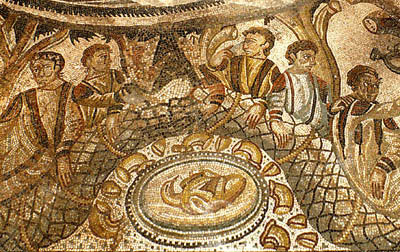Home - In and around
ROMAN VILLA OF THE TELLARO NOTO SYRACUSE SICILY
The villa of Tellaro, near Noto, is a rich suburban residence of the late Roman imperial age
History and description
The remains, found since 1971, are located in a fertile agricultural area, on a low elevation near the Tellaro river, under a seven-nineteenth-century masseria. The central body of the villa, smaller than that of Patti, is built around a vast peristyle. The part of the portico on the northern side had a mosaic floor with laurel festoons that formed circles and octagons with the sides bent including geometric and floral motifs and on it there are two other rooms that preserve the figured mosaics.
In the first of these environments the mosaic, very damaged, retains a panel with the scene of the redemption of the body of Hector: Ulysses, Achilles and Diomedes, identified by inscriptions in Greek, are engaged in weighing the corpse of the hero. The figure of Priam is lost; Hector's body, fragmentary, was on a scale; The gold of the ransom was in the other plate. This episode, not mentioned in Homer's Iliad, probably derives from a tragedy of Aeschylus.
The mosaic floor of the second room presents a hunting scene, with a banquet in the open air between the trees and a female figure interpreted as the personification of Africa.
The scenes of the second environment recall the hunting mosaics of the Villa del Casale in Piazza Armerina, but with more stylized and two-dimensional figures, with uncertain proportions, which make the effect greatly different.
Probably the mosaics are the work of African craftsmen. Based on numismatic evidence, the mosaics were made after the middle of the 4th century AD.
The villa of Tellaro today has been the object of a renewed interest in recent years, thanks above all to a series of renovation and redevelopment projects in the area concerned.
On 15 March 2008, over thirty years after the excavations, the villa of Tellaro was finally inaugurated and made accessible to the public.
Behind the Villa the splendid and sometimes ancient vineyards begin, where even today the traditional local grapes are grown: nero d'Avola, moscato and albanella (or albanello) increasingly difficult to find.
History and description
The remains, found since 1971, are located in a fertile agricultural area, on a low elevation near the Tellaro river, under a seven-nineteenth-century masseria. The central body of the villa, smaller than that of Patti, is built around a vast peristyle. The part of the portico on the northern side had a mosaic floor with laurel festoons that formed circles and octagons with the sides bent including geometric and floral motifs and on it there are two other rooms that preserve the figured mosaics.
In the first of these environments the mosaic, very damaged, retains a panel with the scene of the redemption of the body of Hector: Ulysses, Achilles and Diomedes, identified by inscriptions in Greek, are engaged in weighing the corpse of the hero. The figure of Priam is lost; Hector's body, fragmentary, was on a scale; The gold of the ransom was in the other plate. This episode, not mentioned in Homer's Iliad, probably derives from a tragedy of Aeschylus.
The mosaic floor of the second room presents a hunting scene, with a banquet in the open air between the trees and a female figure interpreted as the personification of Africa.
The scenes of the second environment recall the hunting mosaics of the Villa del Casale in Piazza Armerina, but with more stylized and two-dimensional figures, with uncertain proportions, which make the effect greatly different.
Probably the mosaics are the work of African craftsmen. Based on numismatic evidence, the mosaics were made after the middle of the 4th century AD.
The villa of Tellaro today has been the object of a renewed interest in recent years, thanks above all to a series of renovation and redevelopment projects in the area concerned.
On 15 March 2008, over thirty years after the excavations, the villa of Tellaro was finally inaugurated and made accessible to the public.
Behind the Villa the splendid and sometimes ancient vineyards begin, where even today the traditional local grapes are grown: nero d'Avola, moscato and albanella (or albanello) increasingly difficult to find.



